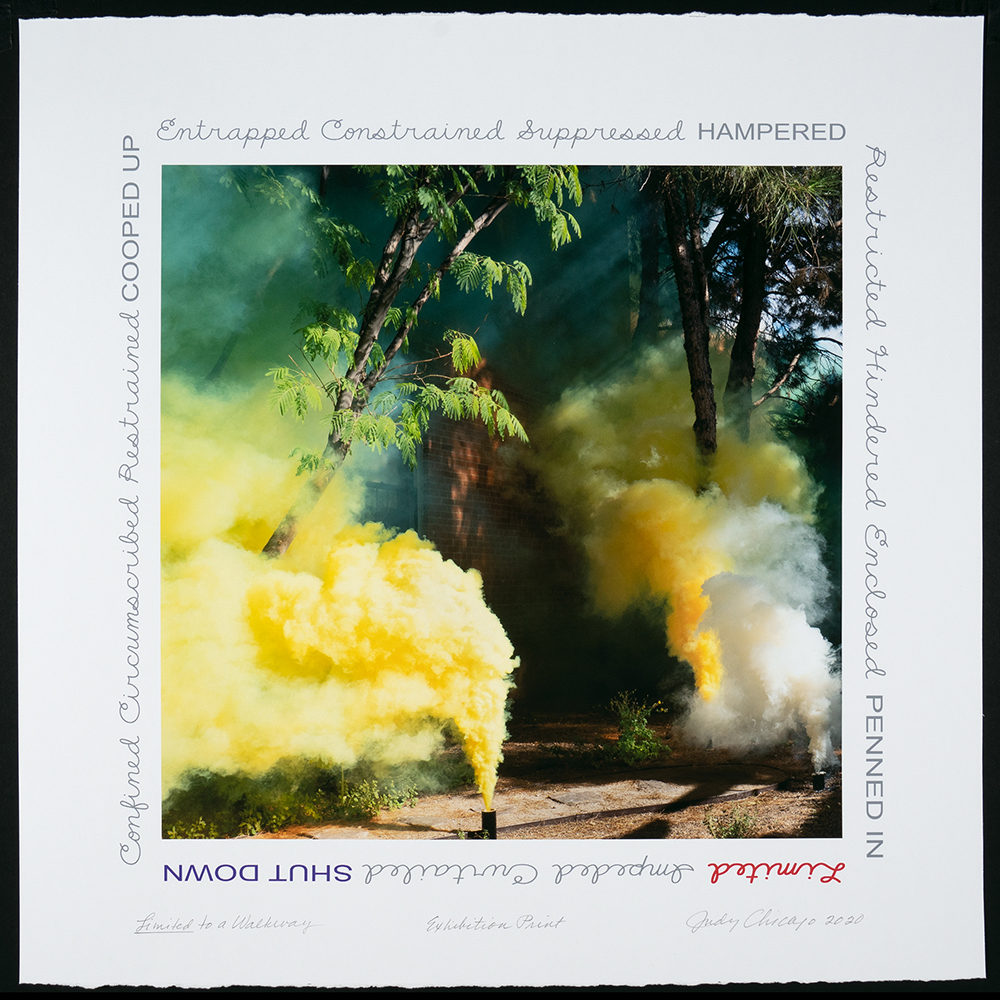Artwork Description
Judy Chicago – Garden Smoke: Limited to a Walkway
Boxed set of 12 prints
Dimensions: 20 x 20″ paper / 16 x 16″ plate
Year: 2020
Medium: archival pigment print on paper
Edition: AP 3 ed. 10
Since March 2020, Judy Chicago has been creating artwork in response to life during the pandemic and the feelings of isolation that it has caused. Her creative impulse culminates with Garden Smoke—a set of 12 prints that document a series of intimate smoke sculptures that Chicago created during the pandemic in her personal gardens in Belen and Albuquerque, New Mexico. The smoke performative works were photographed and printed by Chicago’s artistic and life partner Donald Woodman in Belen where the couple lives and works.
In the months of confinement, Chicago thought she would inspire herself by returning to her early days in California when she drove around with friends, placing colored smoke wherever she wished for a series titled Atmospheres. During the late 1960s and early 1970s when the fight for women’s rights was at the top of social consciousness, Chicago was one of the only women working in the land art genre. Her voice was different from her male counterparts’. She sought to “soften and feminize the environment, if only for a moment,” rather than cutting into the land or attempting to manipulate it as the male artists did. She celebrated the earth with beautiful, transient color, embracing the earth as if it were truly a female “mother.”
Chicago’s intention was to do smoke works to beautify the New Mexico environment during the pandemic, but fire regulations prevented that. Therefore, she turned her attention closer to home and created a series of smokes in her gardens, while attempting to express her feelings about the restricted life COVID-19 produced. The images comprising Garden Smoke are surrounded by words relating to the idea of confinement: enclosed, constrained, suppressed, restricted, curtailed, entrapped, hindered, limited, impeded, restrained, confined, and circumscribed. Yet the glorious colored smoke and natural elements in the images remind us of the splendor in our world, even in the midst of the pandemic. It is almost as if Chicago has provided a visual map for us to cope with the intensity of our feelings during this difficult time.
Chicago’s smoke works are now among her most sought-after. They are the subject of her Smoke, Fire, and Dry Ice archive, the entirety of which was acquired by the Nevada Art Museum in 2020, and will be featured in a major exhibition at the museum in 2021. The Miami Institute of Contemporary Art asked Chicago to create a site-specific smoke work in conjunction with her solo exhibition there in 2019, titled Purple Poem for Miami, and Chicago has been approached by museums throughout the world to show her smoke works—both performatively and in their photographic and print two-dimensional representations. In November 2020, the German firm International Magic will release an app it created in collaboration with Judy Chicago, to allow people to experience being inside one of her smoke sculptures in their own environment. Both the de Young and the New Mexico Art Museum have commissioned Chicago smoke sculptures for 2021, in conjunction with Chicago exhibitions.
Judy Chicago is a pioneer of feminist art since the early 1970s, Judy Chicago advocates issues of women’s liberation and independence through diverse media including paintings, drawings, sculptures, and collaborative installations. Her iconic work “The Dinner Party,” (1974–1979), which is now permanently installed in the Brooklyn Museum of Art’s Elizabeth A. Sackler Center for Feminist Art, is widely regarded as one of the most influential works of feminist art. With Miriam Schapiro, Chicago co-founded the Feminist Art Program at the California Institute of the Arts—the first program of its kind—and collaborated on the formative installation Womanhouse (1972). More recently, Chicago has expanded upon her efforts in gender politics, focusing on broader social issues. Her work has been exhibited extensively at venues such as the Los Angeles Museum of Contemporary Art, the New Museum, the Centre Pompidou, the Whitney Museum, and the Jewish Museum in New York.
Judy Chicago speaks of her work as “trying to infuse women and women’s history with a sense of the sacred and the valuable, because there are all these things associated with women that have been devalued: our bodies, our crafts, our history,” continuing on to say she “tried to bring the same thing to bear on [her] work.”

